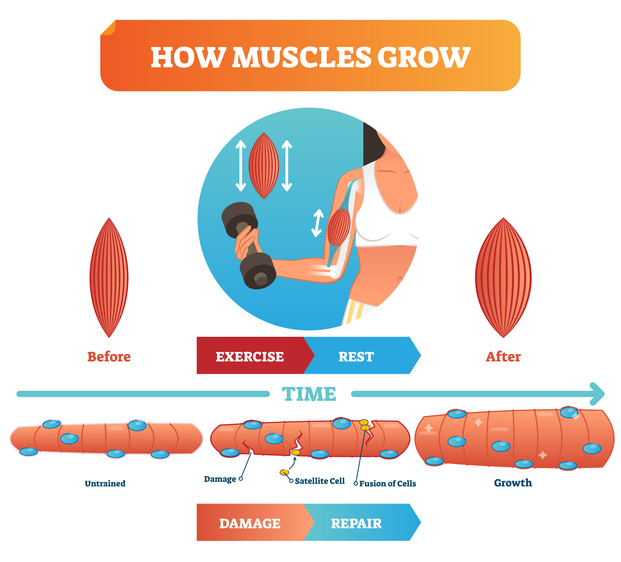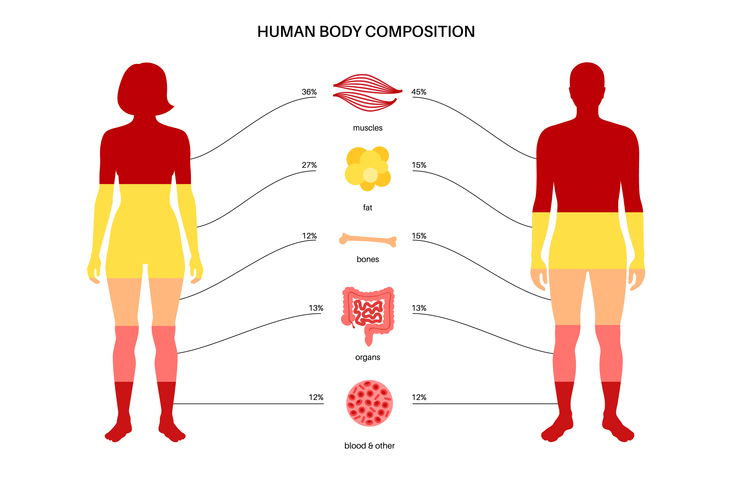How Much Weight Should You Lose per Month?

When it comes to weight loss, we often seek rapid results, hoping for quick fixes. However, achieving sustainable and long-lasting weight loss requires a different approach.

Rapid weight loss methods can have negative consequences, such as:
- Triggering the body’s starvation survival response
- Muscle loss
- Rebound fat gain even beyond the weight you started with
This article will explore the importance of setting realistic monthly weight loss goals to foster healthier and long-lasting transformations.
By understanding the risks associated with losing weight too fast, you can make informed choices and build a healthier relationship with your body. Let’s explore why a measured and balanced approach is vital for our well-being.

What Is a Healthy Amount of Weight to Lose Per Month?
Weight loss generally follows a similar pattern. How weight loss begins is different from how it continues. A systematic study examined weight loss patterns. They found that weight loss tends to occur in stages.
1. Initial Drop
In the first few weeks of starting a weight loss program, it’s common to lose weight quickly. The quick drop in weight is due to:
- Water weight
- Depletion of glycogen stores in the body
- Muscle loss
- Some body fat loss
When you reduce your calorie intake or engage in exercise, your body starts using up stored glycogen, which binds to water. As a result, we lose water weight along with glycogen, leading to a noticeable decrease in overall weight.
Researchers also found that while obese subjects lose mainly energy-dense fat, lean subjects lose relatively large amounts of low energy content fat-free mass (FFM), which includes protein. This means you may lose some protein and fat during the initial weight loss stage.
This initial weight drop will also be larger than other times during your fat loss journey because it happens before your metabolism adapts to the caloric deficit you create.
2. Steady Fat Loss
The second weight-loss stage goes more slowly and lasts longer than the first phase. The weight loss rate typically slows after initial water and glycogen loss. At this stage, the body starts relying more on burning stored fat for energy, which leads to a steady and gradual reduction in weight.
It’s essential to understand that while fat loss occurs more slowly than the initial drop, this is a normal and healthy progression.
3. Plateaus
During a weight loss journey, plateaus are common after several weeks or months of weight loss. The scale seems to stall, and weight loss becomes less noticeable for a period. Plateaus can occur for various reasons, including:
- Metabolic adaptation – meant to save your body from starvation, your body begins to burn fewer calories
- Physical activity changes – sometimes, that initial motivation can begin to wear thin
- Muscle gain from exercise
- Water retention which could arise from exercise-related temporary inflammation, menstrual cycles, supplements like creatine, and other causes
Healthy Rate of Loss
It’s crucial to remember that weight loss is not always linear, and individual experiences may vary. Genetics, lifestyle, and metabolic rate can influence weight loss trajectory.
The key to successful and sustainable weight loss is adopting a balanced approach that includes:
- A healthy diet that produces a caloric deficit while sparing muscles as much as possible (e.g. high protein). Ketogenic diets tend to spare more muscles than non-ketogenic diets given the same amounts of proteins. However, to do keto or not, you should take into account other factors.
- Regular physical activity, ideally with some muscle-sparing resistance training
- A realistic outlook on the pace of progress. Gradual and steady weight loss is more likely to be maintained in the long term and is healthier for the body than crash diets or extreme measures.
Generally, experts recommend aiming for a gradual and sustainable weight loss of 1-2 pounds per week, which translates to approximately 4-8 pounds per month. Losing weight faster than this rate can harm your health and long-term weight loss goals.
Slow weight loss is more successful long term. A study of 42 overweight subjects compared the benefits of slow and rapid weight loss. Both groups lost five percent of their body weight in either five or 15 weeks.
While both slow and rapid weight loss improved their body composition, those who lost weight more slowly were likelier to lose more fat and preserve muscle mass. Researchers also noted that losing weight quickly may put you at a greater risk for later weight gain.
Factors That Affect Weight Loss Speed
Certain factors can affect your progress speed when it comes to losing weight. Understanding how these elements impact your weight loss journey can help create a more effective and personalized strategy. Let’s explore some important factors.
Gender
Studies suggest that men may lose weight faster than women. However, both genders may be even in terms of long-term weight loss.
A study of 1,129 men and women investigated the effects of gender on weight loss during a 12-month program. Researchers determined that men tend to have an advantage in weight loss. Some of their key findings include:
- Men lost 3.3 lb (1.5 kg) more than women in the first 12 weeks of the weight loss intervention.
- Men continued to lose 12.1lb (5.5 kg) more weight than women from their initial assessment up to 12 months.
- Men also maintain their weight and continue to lose more weight post-intervention compared to women.
Another 12-month study found fewer differences between genders. Overall, men and women lost the same weight. Women, however, reduced their body weight by about 3% more than men.
Researchers also observe that greater social pressure to diet and be thin may influence the long-term success of women.
Menstrual Cycle

Women’s hormones and menstrual cycle may prevent women from losing weight as quickly as men. Not only does it influence energy intake and calories burned, but you also store additional weight (in fluid) in preparation for a possible pregnancy each month.
The menstrual cycle has two overall phases:
- Follicular phase (day one of bleeding until ovulation)
- Luteal phase (after ovulation)
During the menstrual cycle, estrogen and progesterone levels fluctuate to regulate physiological changes, including appetite and cravings. Estrogen levels rise during the follicular phase and peak just before ovulation. Progesterone levels increase during the luteal phase following ovulation.
Estrogen interacts with brain centers that control hunger and satiety. Researchers believe estrogen can decrease your appetite and increase your sense of fullness. On the other hand, progesterone may slightly stimulate appetite in some individuals, particularly during the luteal phase.
The luteal phase and premenstrual syndrome can undermine your weight loss goals. During the luteal phase, you can burn 90 – 280 calories more as your body temperatures increase slightly. You also get hungrier and eat more, up to 500 calories or more even. You tend to crave high-carbohydrate and high-fat foods while using less carbohydrates during exercise.
The good news is that your body tends to work with you, and your energy expenditure also increases during the luteal phase. It’s essential to be aware of what’s happening in your body throughout your cycle to ensure those cravings don’t get the best of you.
Exercise
While exercise is important for overall health and can support weight loss, it may not have the immediate impact you’d expect.
Increased Appetite
A controlled study of 200 men and women explored the impact of exercise on weight loss. Participants underwent supervised exercise interventions of varying intensities over 24 weeks. They participated in supervised training to burn either 3.6 calories/lb (8 cal/kg) or nine calories/lb (20 cal/kg) weekly.
When subjects exercised, they burned more energy than expected. However, they didn’t lose as much weight as predicted because they ate more to compensate for the extra energy they burned.
The study suggests that focusing on reducing energy intake alongside exercise may be more effective for weight loss. Exercising alone is an ineffective long-term weight loss strategy.
Water Retention
Water retention is another culprit for a lack of speedy weight loss with exercise. During exercise, especially in hot and humid conditions, the body sweats to regulate its temperature. As a result, you can lose a significant amount of water and electrolytes through sweat.
If you don’t drink enough proper fluids after exercise, the body senses the fluid loss and tries to compensate for it. One way the body does this is by holding on to water to prevent dehydration and maintain essential bodily functions. This water retention can make it seem like you’re holding on to more pounds than you actually are.
Water retention is not the same as gaining fat or muscle mass. It is typically a short-term response, and once you rehydrate adequately, your body will restore its fluid balance, and the temporary water retention will subside.
To prevent dehydration and the associated water retention after exercise, it’s essential to stay well-hydrated by drinking enough water before, during, and after physical activity.
A placebo-controlled study of 15 men explored the best ways to rehydrate after exercise. Participants received an electrolyte beverage with either three, six, or 12 percent carbohydrates. All participants consuming a combination of carbohydrates and electrolytes experienced greater fluid retention than just drinking water for rehydration.
This means drinking something with electrolytes and carbohydrates will help you rehydrate faster and allow your body to release any fluids it may be holding onto to avoid fluid loss.
Beware of calories and nutritional content, however. Some sports drinks can be high in calories and sugar.
The amount of fluid needed with your workout varies depending on how long and intense your exercise is and how much you naturally sweat. Paying attention to your body’s thirst cues and drinking fluids regularly throughout the day can help you stay hydrated and prevent water retention.
Muscle Growth
Muscle gain can slow down weight loss, but it is not necessarily bad. Let’s break down the relationship between muscle gain and weight loss.
- Muscle is denser than fat: Muscle tissue is denser than fat tissue, meaning muscle weighs more than fat for the same volume. So, when you gain muscle and lose fat, your body composition improves, but the scale may not show a significant decrease in weight.
- Muscle burns more calories: Unlike fat, which is relatively metabolically inactive, muscle tissue requires more energy to maintain itself. As you gain muscle, your basal metabolic rate (BMR) increases because your body needs more calories to sustain the additional muscle mass. This can lead to an increase in daily calorie expenditure.
Therefore, muscle gain can slow down weight loss on the scale due to the denser nature of muscle tissue and the increase in BMR.
However, focusing solely on weight loss might not provide a complete assessment of your fitness journey. Building muscle benefits overall health, body composition, and long-term weight management. Instead of only tracking weight, you should also track these measurements.

Sleep
The quality of sleep you get can seriously affect how quickly you lose weight. Higher quality sleep can mean faster weight loss.
A study of 125 adults explored the relationship between sleep quality and weight loss. Subjects participated in a 12-month behavioral weight loss intervention while also being monitored for sleep quality based on questionnaires and physical monitoring. Participants with better sleep health lost more weight than those with poor sleep health.
A literature review provides us with some reasons why sleep affects how quickly you lose weight:
Metabolism
Not getting enough sleep can negatively affect your metabolism. Lack of sleep may reduce resting metabolic rate (the number of calories your body burns at rest), making it more challenging to lose weight.
Hormonal Regulation
Poor sleep can disrupt the balance of hormones that regulate appetite, such as leptin and ghrelin. Leptin helps to suppress appetite, while ghrelin stimulates hunger. When you don’t get enough sleep, the levels of leptin decrease and ghrelin levels increase. Increased hunger and cravings can contribute to weight gain.
Other hormones also change less favorably for fat loss. You can learn more about this in our article “Why Sleep Deprivation Makes You Hungry and Fat.”
Energy and Physical Activity
Poor sleep can leave you feeling fatigued and lacking energy, which may reduce your motivation to engage in physical activity and exercise. Regular exercise is essential for weight loss by helping burn calories and increase lean muscle mass.
Emotional Well-being
Not getting enough sleep can affect your mood, increasing the likelihood of stress, anxiety, and depression. Emotional factors can influence eating behaviors and lead to overeating or making unhealthy food choices, hindering weight loss efforts.
Insulin Sensitivity
Sleep deprivation can reduce insulin sensitivity and throw off blood sugar control. These, together with more food cravings and hunger, can make you store more fat, making weight loss more challenging.
To optimize weight loss efforts, prioritize healthy sleep habits. Aim for around seven to nine hours of sleep per night. Check out this article on “How To Maximize Your Sleep Quality For Optimal Health, Muscles, And Performance.”
The Right Fat Loss Speed
Beyond just losing weight, you may be wondering about fat loss. It’s easy to know whether you are losing weight. You just jump on a scale and look at a number. But what about fat loss?
Tracking Fat Loss Instead of Weight
The right way to track fat loss is by using a combination of measures. The quickest way is by paying attention to how you look and feel. Are your clothes fitting differently? Do you look different in photos?
If you’re looking for a more exact way, you can track your progress using skinfold calipers to measure your body fat percentage.
The most accurate way of measuring your body fat, muscle mass, and bone density is with hydrostatic weighing. While hydrostatic weighing is the most accurate, it’s inconvenient and only available in research labs.
Whereas, DEXA (dual-energy X-ray absorptiometry) scans have the second-best accuracy and are more accessible. You can learn more about tracking your fat loss with this helpful article.

Healthy Fat Loss Rate
Just like weight loss, fat loss is not linear. Generally, you can expect to lose more fat when you first begin a new weight loss plan and if you have a higher body fat percentage. How quickly you lose fat beyond that depends largely on your consistency with following your diet and exercise program.
Here’s a good idea of what to expect per week :
| Consistency | % Body Weight | Fat Loss for Men | Fat Loss for Women |
| 90 to 100% | 1-1.5% body weight | 2-3 lbs | 1.65-2.5 lbs |
| 70 to 85% | 0.5-1% body weight | 1-2 lbs | 0.8- 1.65 lbs |
| 50 to 65% | <0.5% body weight | <1 lb | <0.8 lb |
Remember, as you lose body weight, It’s normal to experience plateaus. As you become leaner, your fat loss rate will slow down. But don’t get discouraged, fat loss is a marathon, not a sprint.
Mitigating Metabolic Adaptation
Just like overall weight loss, it’s normal for fat loss to slow down when you restrict calories due to metabolic adaptation. There are strategies, however, to help mitigate the struggle, like diet cycling and breaks.
Diet cycling involves alternating between periods of calorie restriction and periods of maintenance or higher calorie intake. Let’s break it down into two phases:
- Calorie Restriction: You eat fewer calories than your body needs to create a calorie deficit and promote weight loss. This phase can last for a few weeks to a few months.
- Maintenance or higher calorie phase: Transition to a period of eating at maintenance or slightly higher calories. This phase allows your metabolism to adjust and recover. It’s shorter than the calorie restriction phase, lasting anywhere from one meal to a few weeks.
Taking these diet breaks can help minimize metabolic adaptation and give you a much-needed mental break. Constantly ensuring you’re getting the right amount of food can be taxing. Overall, it can support you in making your weight loss journey more sustainable.
A study of 51 men explored the effects of intermittent versus continuous energy restriction on weight and fat loss. Participants in the study either consistently ate fewer calories than needed for 32 weeks (continuous energy restriction) or alternated between two weeks of a calorie deficit and two weeks of energy balance (intermittent energy restriction).
Participants in the intermittent group lost an average of 31 lb (14.1 kg), while the continuous restriction group lost an average of 20 lb (9.1 kg) of weight. Therefore, weight loss is likely more efficient when you interrupt energy restriction with breaks.
If you’re focusing specifically on fat loss, here’s an informative article on what type of cardio is best.
Conclusion
Sustainable weight loss requires a measured and balanced approach, avoiding rapid methods that may backfire. Here are some tips on where to start:
- Set realistic goals. Aim to lose a healthy rate of 1-2 pounds per week or 4-8 pounds per month. These can correspond with 0.5 – 3 lbs of body fat per month, depending on many factors.
- Be aware of the factors discussed in this article that may seem like you’re not making progress, even though you’re still on the right track.
- Get quality sleep.
- Ensure that your weight loss plan is sustainable by going slowly and incorporating diet cycling and breaks.
- Focus on a healthier lifestyle, not just shedding pounds.
Finally, I invite you to explore the wisdom within our new book, The Ultimate Nutrition Bible. This empowering book will guide you through personalized diet strategies to achieve your ideal weight and maintain it long-term.
- Heymsfield SB, Thomas D, Martin CK, et al. Energy content of weight loss: kinetic features during voluntary caloric restriction. Metabolism. 2012;61(7):937-943. doi:10.1016/j.metabol.2011.11.012
- CDC. Losing weight. Centers for Disease Control and Prevention. Published June 15, 2023. Accessed August 29, 2023. https://www.cdc.gov/healthyweight/losing_weight/index.html
- Ashtary-Larky D, Ghanavati M, Lamuchi-Deli N, et al. Rapid weight loss vs. Slow weight loss: Which is more effective on body composition and metabolic risk factors? Int J Endocrinol Metab. 2017;In Press(In Press). doi:10.5812/ijem.13249
- Bhogal MS, Langford R. Gender differences in weight loss; evidence from a NHS weight management service. Public Health. 2014;128(9):811-813. doi:10.1016/j.puhe.2014.06.019
- Woźniak J, Woźniak K, Wojciechowska O, Wrzosek M, Włodarek D. Effect of age and gender on the efficacy of a 12-month body weight reduction program conducted online—A prospective cohort study. Int J Environ Res Public Health. 2022;19(19):12009. doi:10.3390/ijerph191912009
- Geiker NRW, Ritz C, Pedersen SD, Larsen TM, Hill JO, Astrup A. A weight-loss program adapted to the menstrual cycle increases weight loss in healthy, overweight, premenopausal women: a 6-mo randomized controlled trial. Am J Clin Nutr. 2016;104(1):15-20. doi:10.3945/ajcn.115.126565
- Rogan MM, Black KE. Dietary energy intake across the menstrual cycle: a narrative review. Nutr Rev. 2023;81(7):869-886. doi:10.1093/nutrit/nuac094
- Westerterp KR. Exercise for weight loss. Am J Clin Nutr. 2019;110(3):540-541. doi:10.1093/ajcn/nqz070
- Sayer L, Rodriguez-Sanchez N, Rodriguez-Giustiniani P, et al. Effect of drinking rate on the retention of water or milk following exercise-induced dehydration. Int J Sport Nutr Exerc Metab. 2020;30(2):128-138. doi:10.1123/ijsnem.2019-0176
- Osterberg KL, Pallardy SE, Johnson RJ, Horswill CA. Carbohydrate exerts a mild influence on fluid retention following exercise-induced dehydration. J Appl Physiol. 2010;108(2):245-250. doi:10.1152/japplphysiol.91275.2008
- Etchison WC. Letter to the editor response. Sports Health. 2011;3(6):499-499. doi:10.1177/1941738111422691
- Zurlo F, Larson K, Bogardus C, Ravussin E. Skeletal muscle metabolism is a major determinant of resting energy expenditure. J Clin Invest. 1990;86(5):1423-1427. doi:10.1172/jci114857
- Kline CE, Chasens ER, Bizhanova Z, et al. The association between sleep health and weight change during a 12-month behavioral weight loss intervention. Int J Obes (Lond). 2021;45(3):639-649. doi:10.1038/s41366-020-00728-8
- Hirotsu C, Tufik S, Andersen ML. Interactions between sleep, stress, and metabolism: From physiological to pathological conditions. Sleep Sci. 2015;8(3):143-152. doi:10.1016/j.slsci.2015.09.002
- Ponti F, Plazzi A, Guglielmi G, Marchesini G, Bazzocchi A. Body composition, dual-energy X-ray absorptiometry and obesity: the paradigm of fat (re)distribution. BJR Case Rep. 2019;5(3):20170078. doi:10.1259/bjrcr.20170078
- Precisionnutrition.com. Accessed August 29, 2023. https://www.precisionnutrition.com/rates-of-fat-loss-and-muscle-gain
- Byrne NM, Sainsbury A, King NA, Hills AP, Wood RE. Intermittent energy restriction improves weight loss efficiency in obese men: the MATADOR study. Int J Obes (Lond). 2018;42(2):129-138. doi:10.1038/ijo.2017.206




